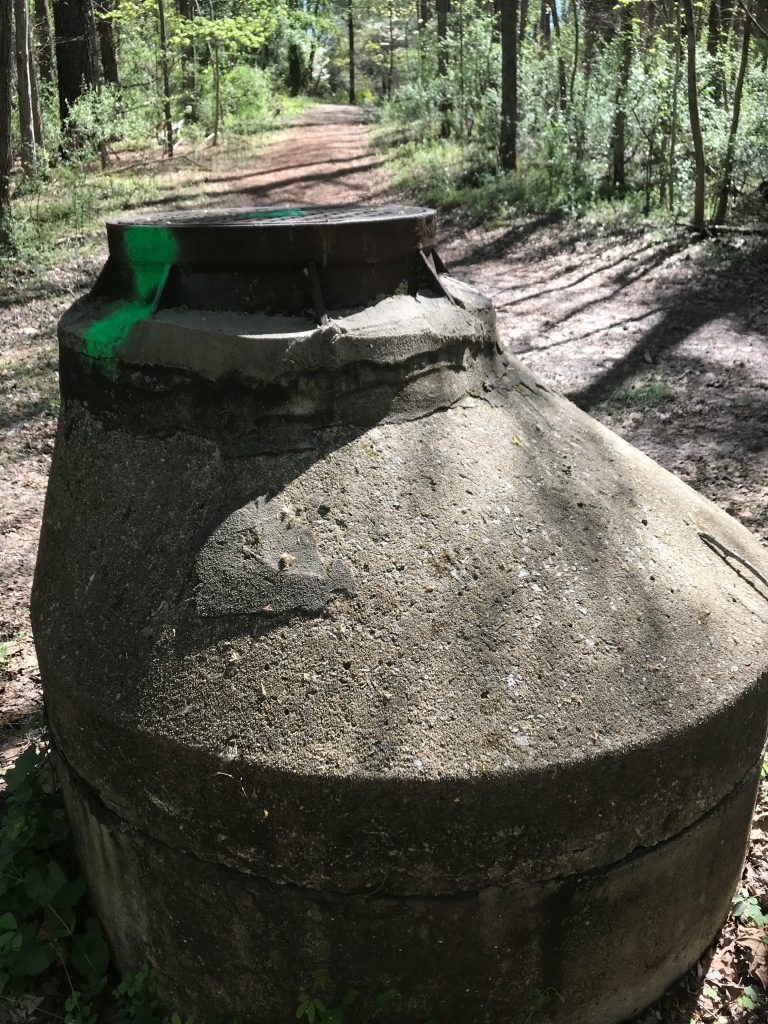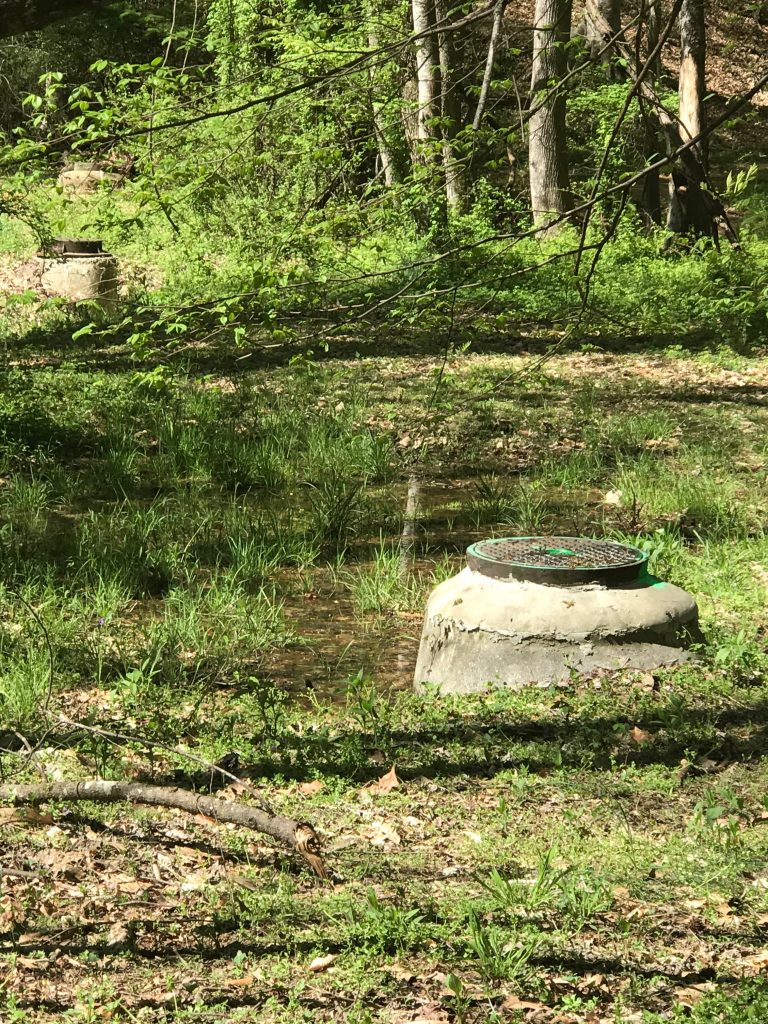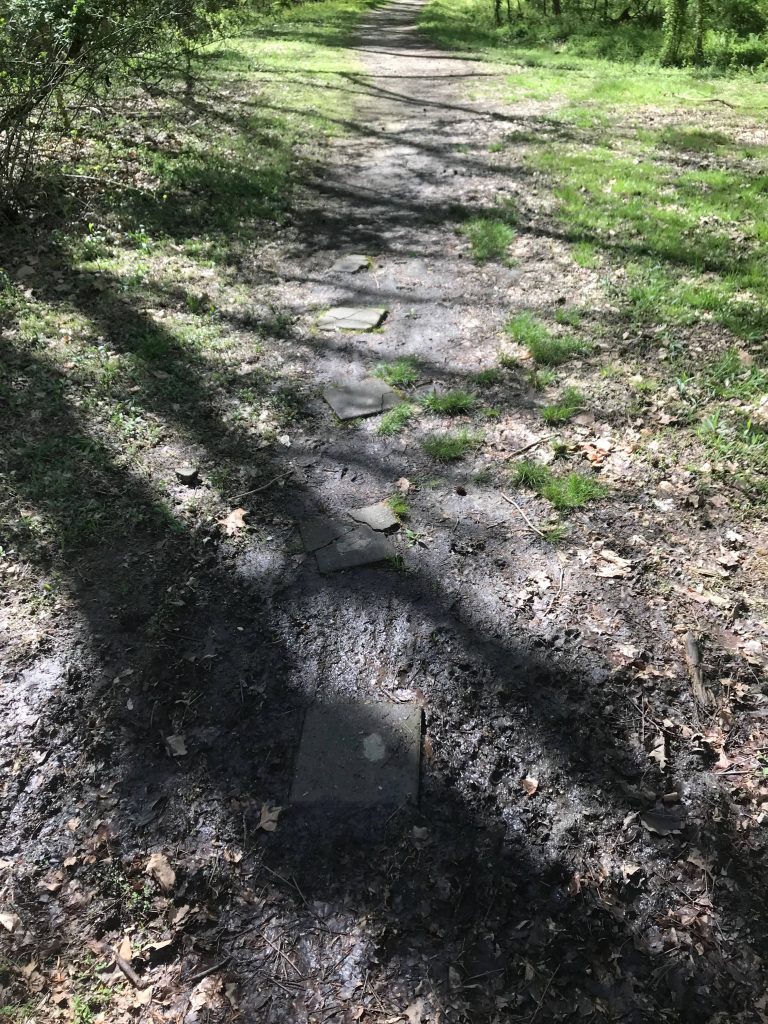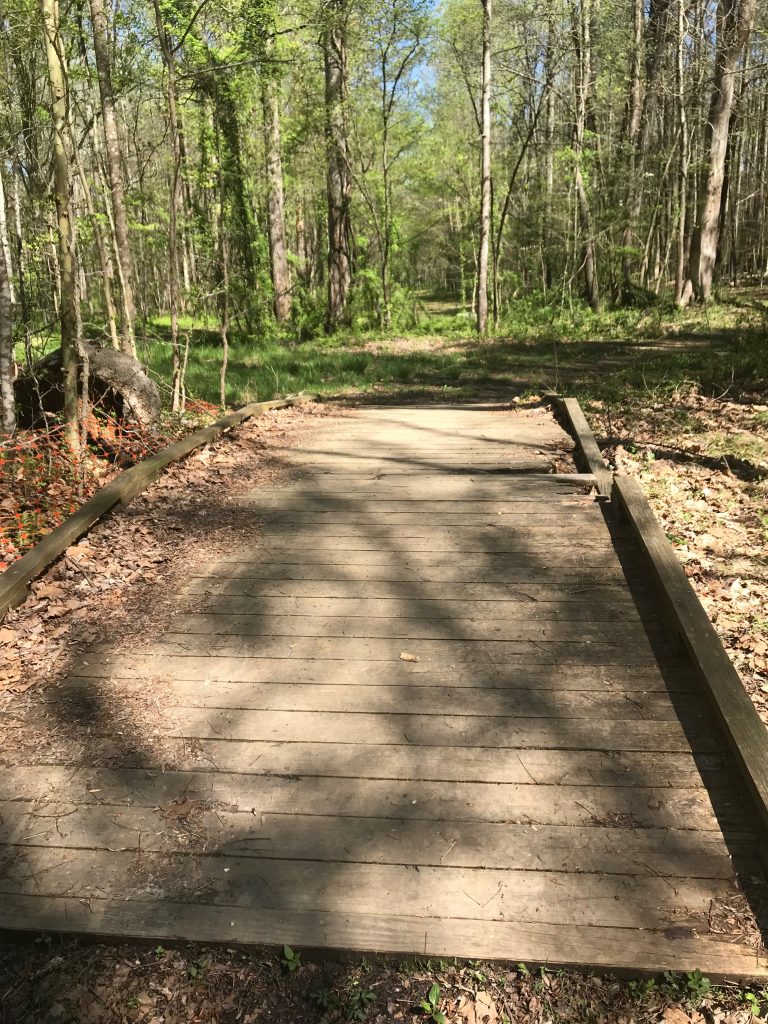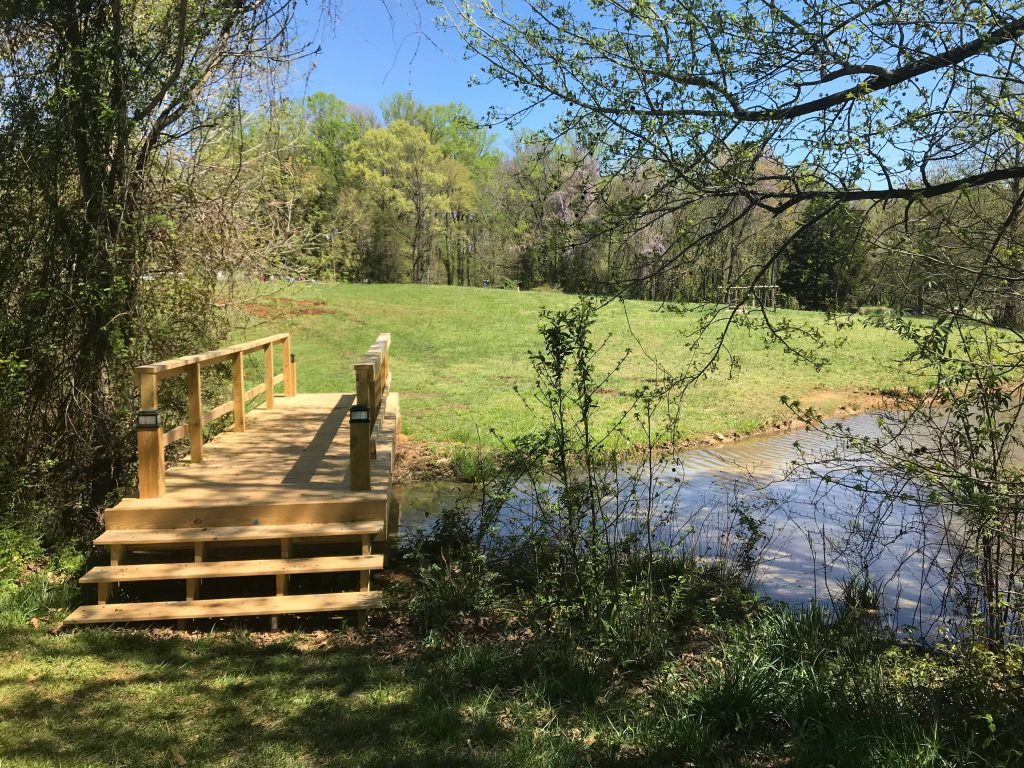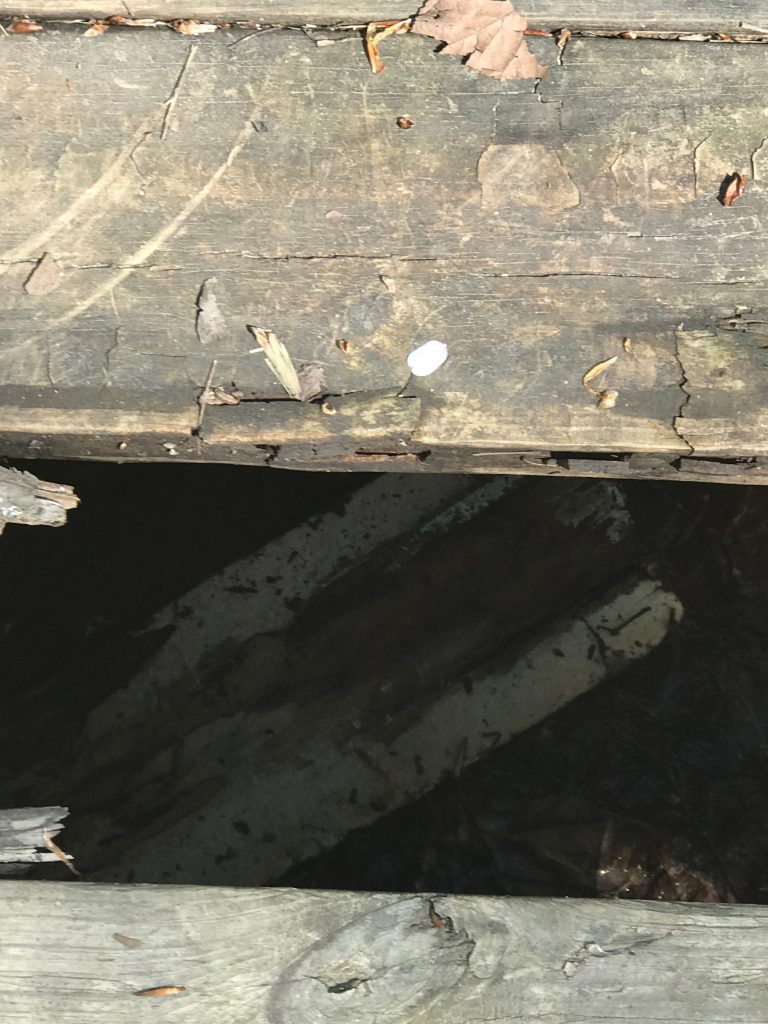Category: Uncategorized
Winter Walk In The Guilford Woods
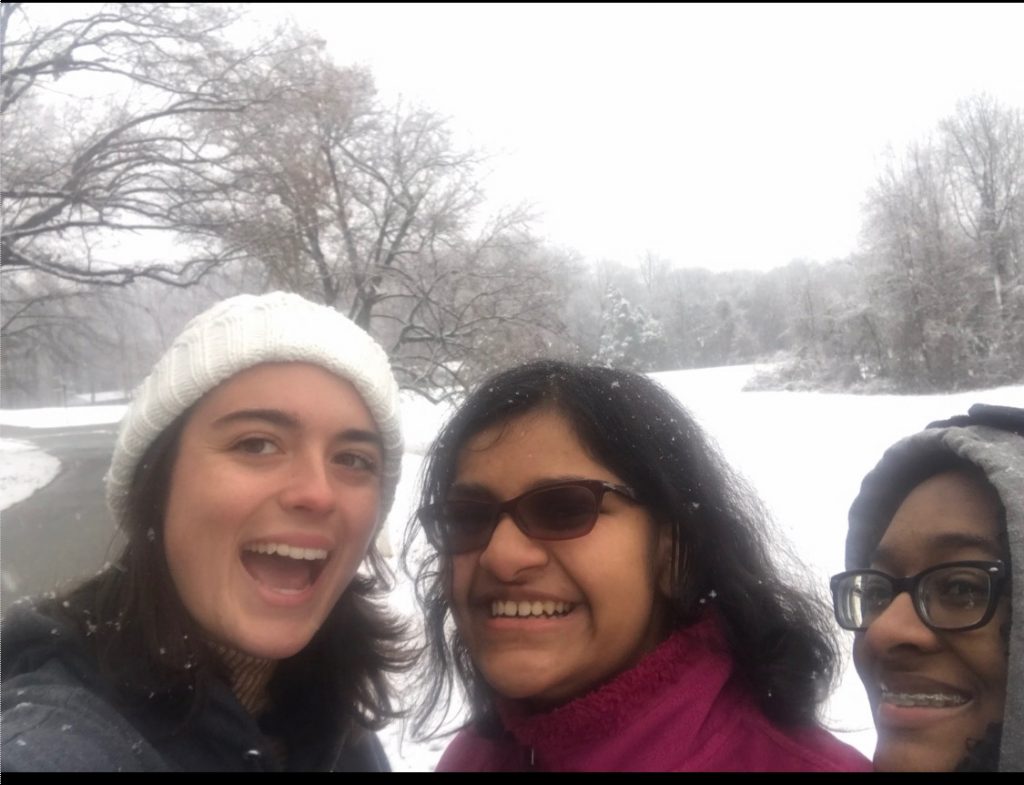
On a snowy December 9th, 2017 my friends Natalie, Momo, and I set off into the white wilderness to get some great pictures, which we coined “Snow-to Shoot.” Setting off together made us forget that the recent “Snowpocalypse” (the term for a particularly snow-filled North Carolina winter) had made our bustling campus a ghost town, with people rushing to go inside rather than sitting around outside, and guardedly walking around the deadly frozen walkways. We laughed and chatted along the way, but all hell broke loose when we got to the pristine snow. It was simply too good an opportunity to resist.
Suddenly I found myself with a face full of snow. In lieu of snowballs, Momo had taken to dumping handfuls of snow on us. At this point, luckily, the snow was still very powdery and at least 2-3 inches around us. Retaliation was inevitable, swift, and snowy, and soon we were all shivering with delight. We trudged up to the Lake, which is where we ran into the Muscovy Ducks (see the post Lackin’ Quackin’ for more details). The Lake had not frozen over, but the only other waterfowl I could see on the water was a Canada Goose. The plants near the bank were sparsely covered with snow, though much more so further into the lawn. Underneath, the leaves and stalks that hadn’t turned brown were green, and perhaps it is because the packed snow provided adequate insulation.
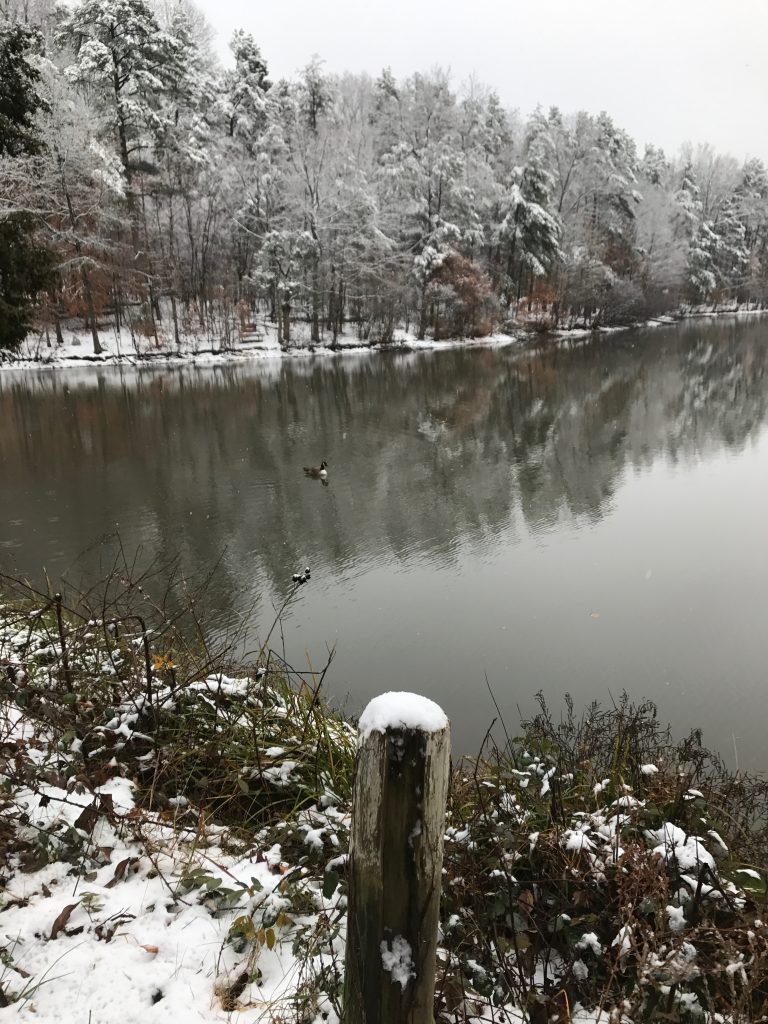
Through seeing the Guilford College Woods in the winter from this vantage point, I had the opportunity to appreciate just how many trees had kept their greenery by virtue of either their status as evergreens or tolerance of cold temperatures. It was interesting comparing the ground cover near the Guilford College Lake, versus in the Woods. Given that the ground in the Woods is mostly dirt on the trails, the area was very muddy where tracks could be seen. Deeper in the woods, most of the trees were leafless by now, and the shrubs and trees seemed to be entangled in each other.
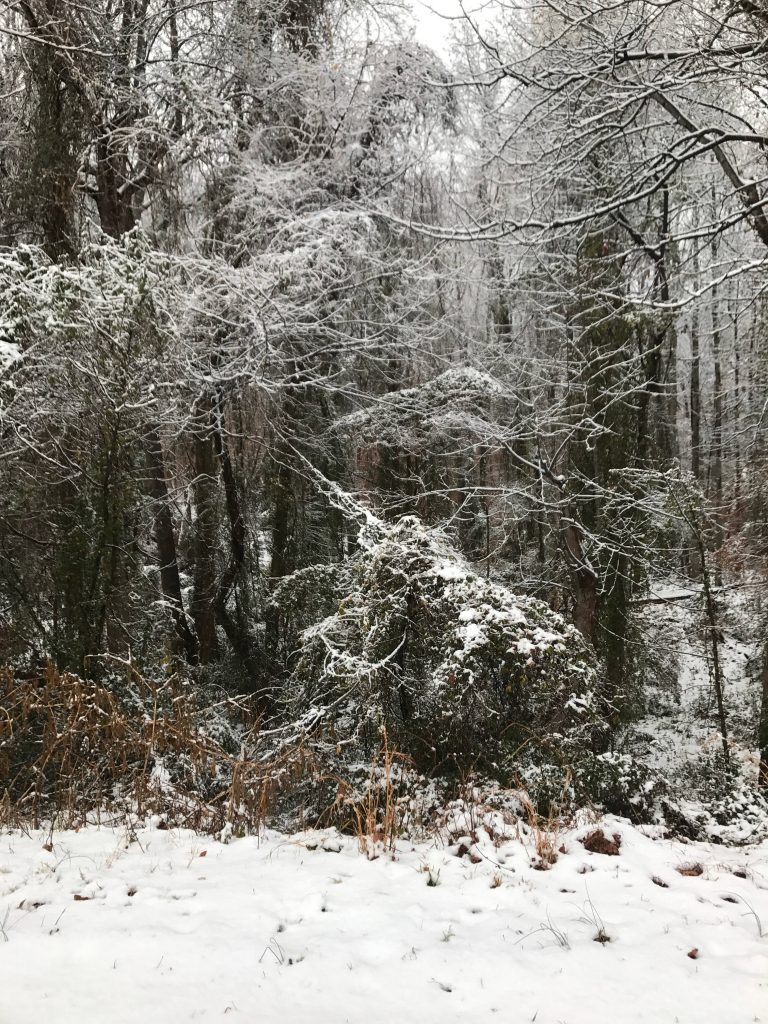
Below was one of the many bridges we had found and taken pictures on. This particular part of the woods was full of American Beech trees, which have fascinating leaves.
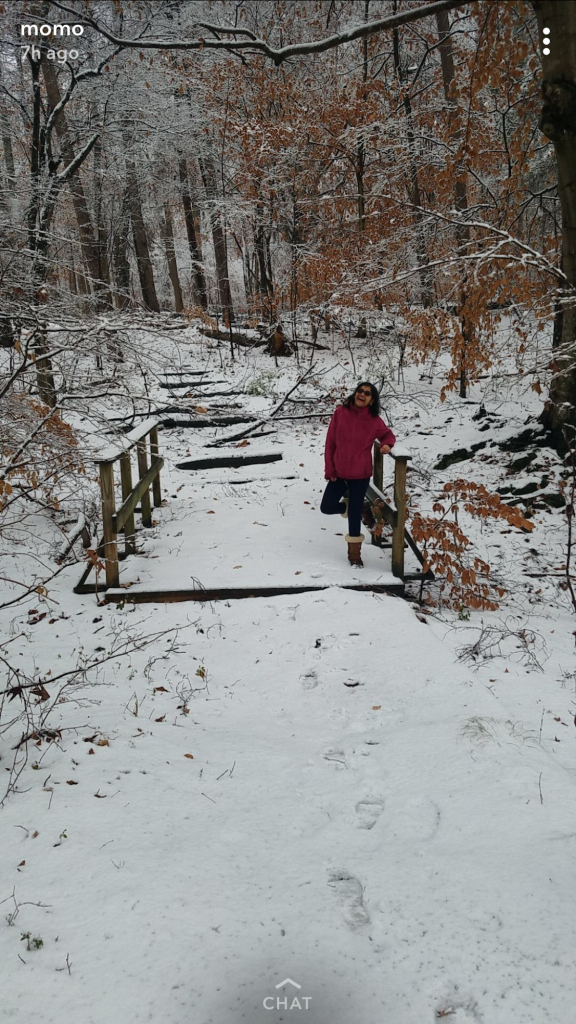
As you can see in both the picture above, and probably much more clearly in the picture below, the leaves have jagged edges, and it’s winter twigs are particularly unique because they’re long, thin, and have rows of leaves on either side.
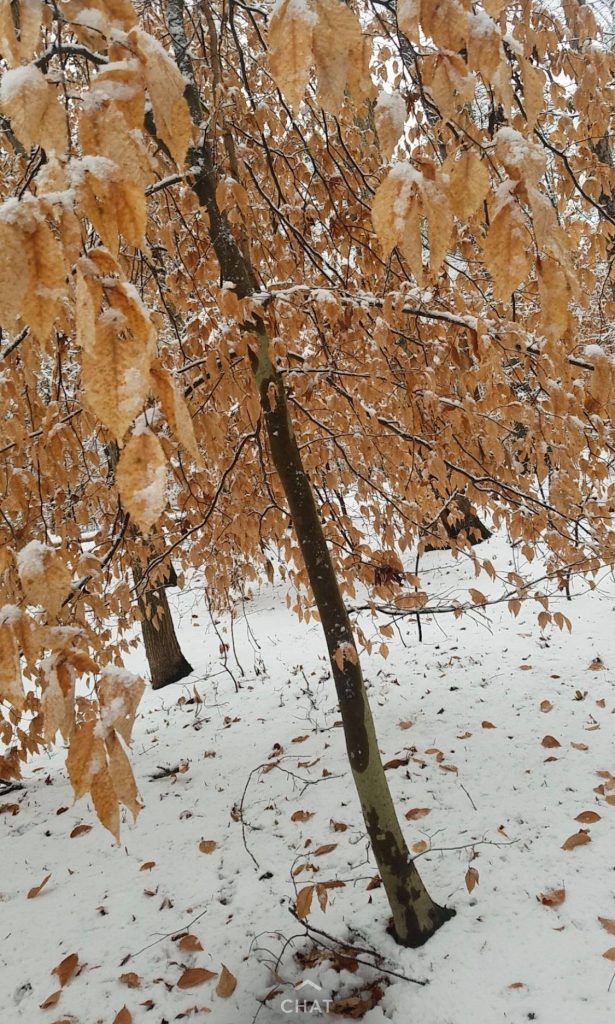
In winding back down that open road, in the rendered ghost town of Guilford College, we were able to reflect how we transformed nature into our winter wonderland, just by delving wholeheartedly in.
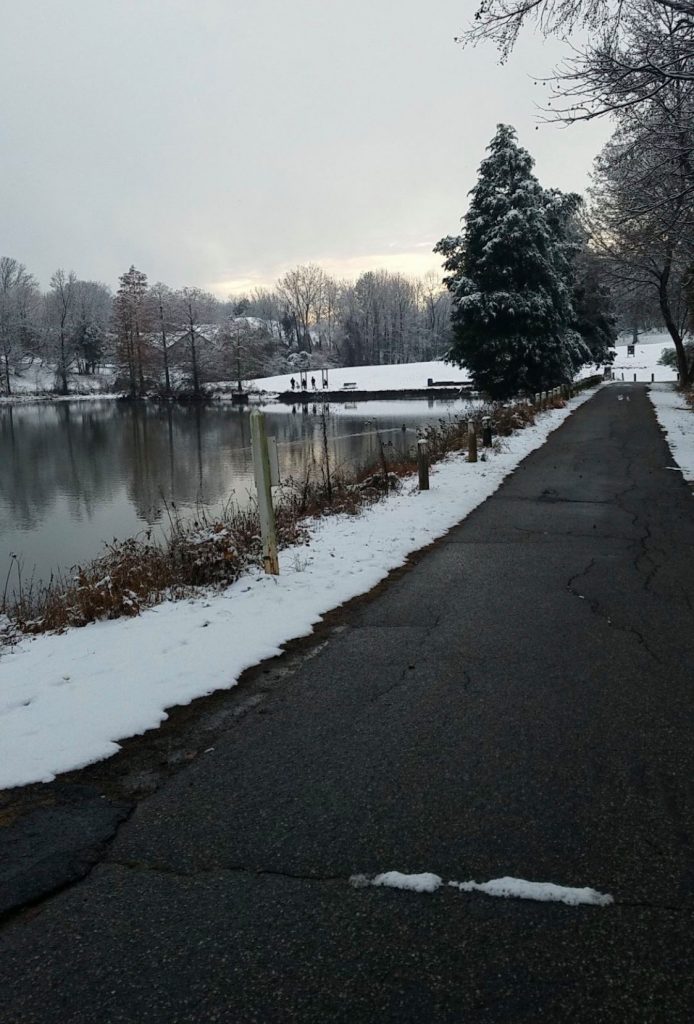
Triad Park: A Place for Everyone
Triad Park has been around since the 90s. The idea of the park has existed since the 60s. However, the land dates back far before any human came up with the idea to develop upon it and give it a name. Since it became a park, countless Triad-based and other individuals have flocked to the patch of land to practice mindfulness and enjoy the beauty of nature. I’m grateful to have such a nice place so near my home.
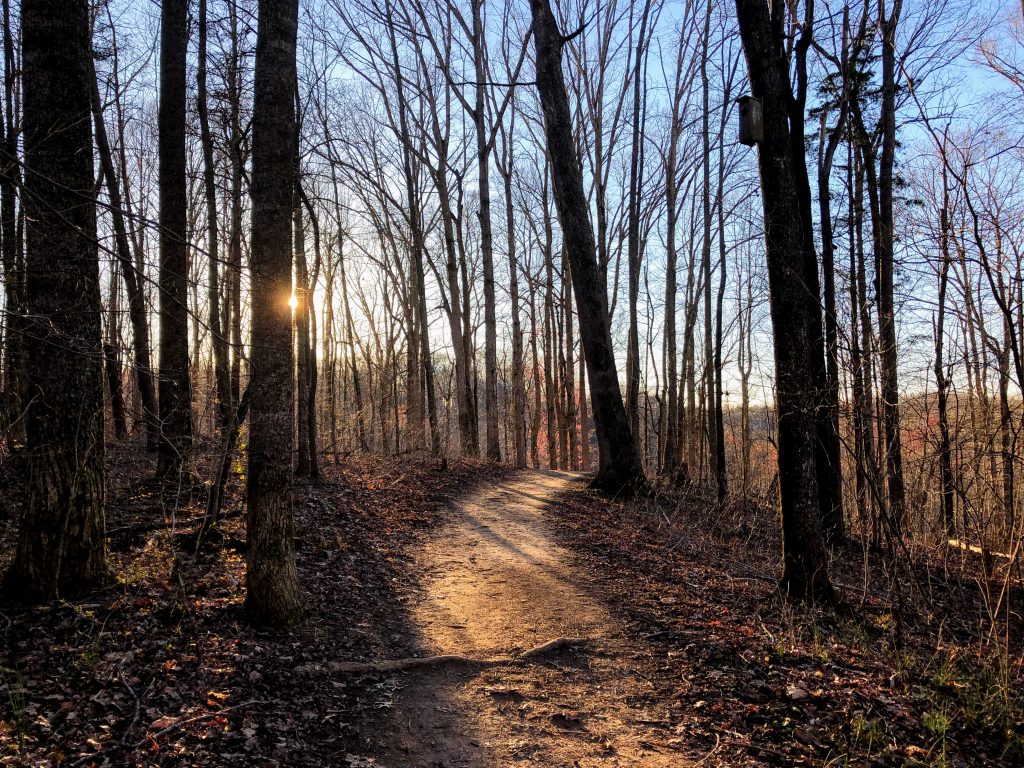
One of my fondest memories of Triad Park is spotting a flock of wild turkey during an October hike in the woods. Meleagris gallopavo, as science calls them, are actually pretty common around the Triad area. They have been spotted numerous times in the field near my house as well. However, I never thought that I may see some at Triad Park. It was a treat, to say the least, one of which I won’t forget.
A fun fact about wild turkey is that they are the same species as the domestic turkey. This makes sense, given that the ones that I saw on the trail were just as big as the turkey I have seen in captivity (or on the dinner table–too soon?). My best friend Alee has a fear of wild turkey, so I took all the more pleasure in informing her that wild turkey was migrating in the general direction of her house.
Another fond memory of the park involves sliding down the steep hill part of the trail while it was covered with snow. I ended up faceplanting in the snow, but it is still a memory that I will not forget. It is interesting to compare the memories I have of the wildlife around the Triad Park area with general memories of my interactions within the space with my friends and family. The memories are not in a short supply, that is for sure.
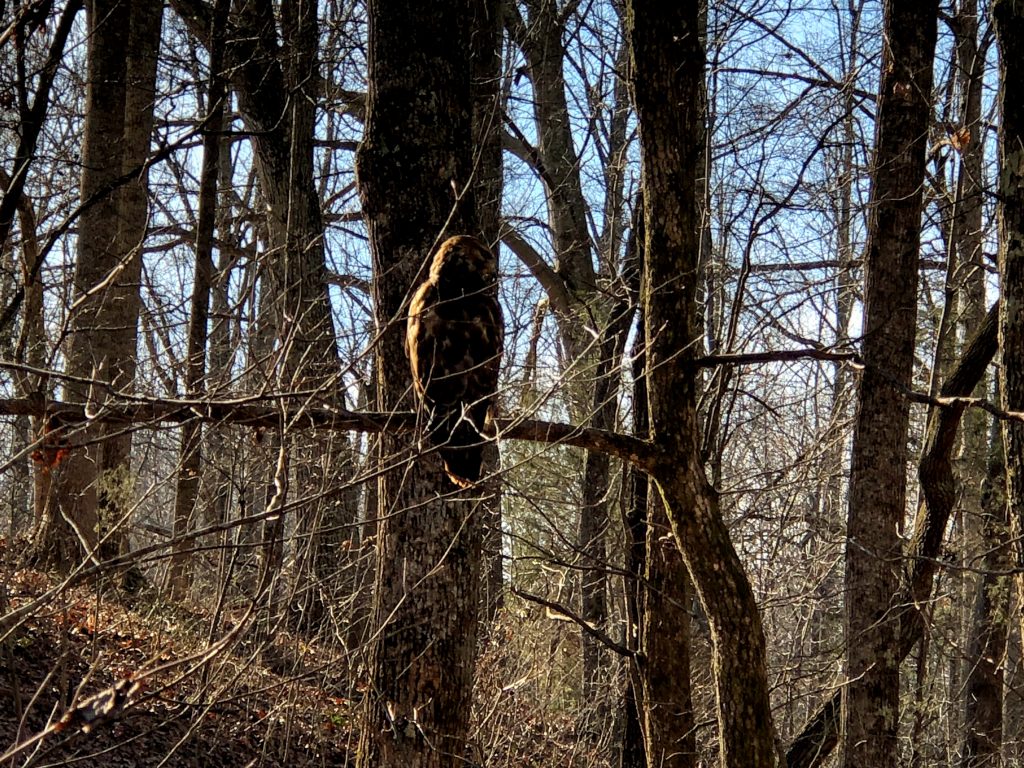
Remembering the good times at Triad Park would not be complete without discussing the park’s local Cooper’s Hawk. Cooper, as I like to call him, can be seen usually during the afternoon calling from a tree branch somewhere usually out of sight. One of my favorite memories of Cooper is when he got close enough to allow me to take pictures of him. Normally Cooper’s Hawks are wary of human presence and fly away at the sight of us. However, the hawk pictured above did not seem that shy as I walked by him.
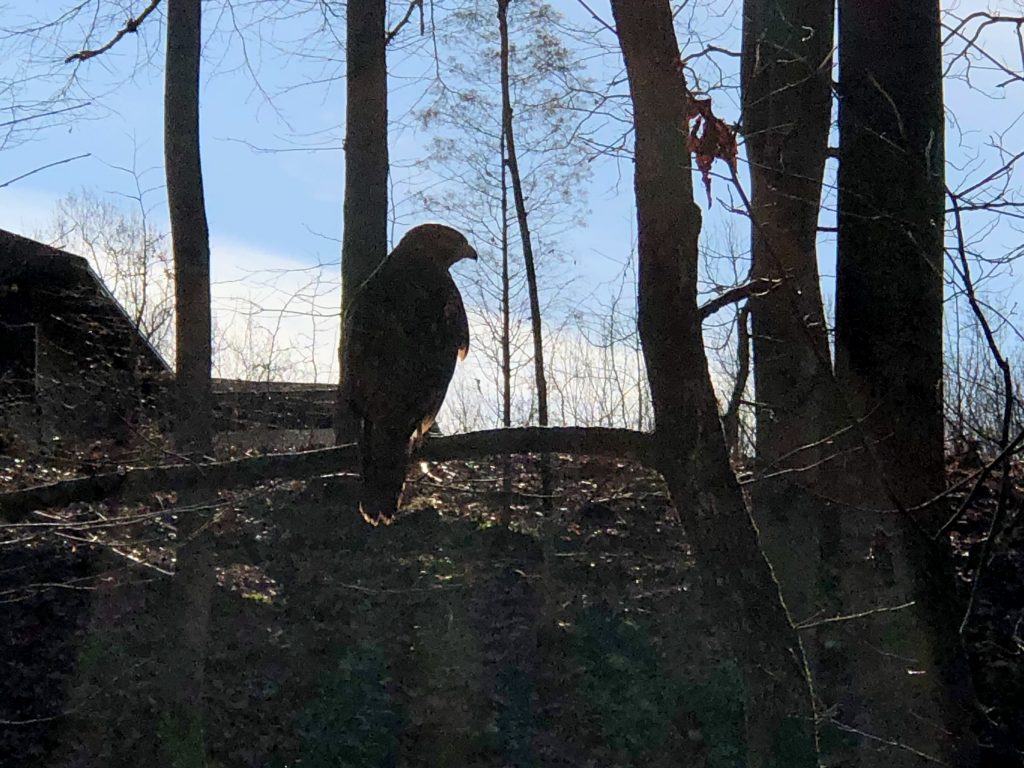
I am very thankful for the times that wildlife has presented itself to me during my hikes on the trail. From white-tailed deer, who are usually seen traveling in packs, to the Pileated Woodpecker, who are more rare to spot than the deer, but are commonly either seen hopping on the ground or flying from tree to tree. It’s no surprise that so many people enjoy coming to Triad Park; it really has everything a human or non-human animal could it. It truly is a place for everyone.

The Death of Life
There was a drought at Carvins Cove, Roanoke, Virginia in 2002. I asked my mom and grandmother, who are from this community, if anything like this had ever happened before. Neither of them could recall. My grandmother is in her 70s so at least in that span of time, the answer was no. Although I was very young, I remember all the brown and dry cracked dirt, I felt like I was standing on a mountain.

I remember it not being as peaceful and the feeling of excitement and joy I had always felt going there being absent. As a child I could see the difference in the adults’ behavior but of course had no idea what it all meant. Just that not only was it different for me but my family as well. Everyone behaved differently because we all have a relationship with this space in different ways and I guess that is why it is burned into my remembrance. That was the one time I remember we didn’t stay. I didn’t get to play and run around. We didn’t have a picnic or cook out and enjoy ourselves. That was our routine and this time none of that happened. In all the times I have been since then and see the water lapping at the edge of the shoreline and the boats backing in at the dock, I have a flash of what it looked like to see the dock standing alone with no water around it and being able to walk a block or more to the water’s edge. It was a sobering sight. That event has really given me an appreciation and thankfulness as to how it looks today.

The beauty I see now and take in to my spirit. The blessing that has always been there really resonates with me now. Most people don’t realize the beauty in simple things, like the water tickling your toes you hang the off the dock in the water.The whole world was that little corner to me, memories whizzed by through the car window, as if they only wanted to be seen for a moment. Now as I travel through the community my ancestors have lived in my whole life, past my great-grandparents home and along the winding road that takes me there and I see the clearing come into view I realize the gift. I try to take it all in since I live away and am not able to go there on multiple occasions in the summer like I did when I spent time with my grandparents in Virginia. It is true to say Virginia is for lovers, it is for lovers of the world and its great spaces, for reconnecting with who you are, realizing your mortality, and accepting it. The moments are few but the impact is greater as I enjoy my pot of gold at the end of the rainbow. One of the jewels of a small community that was once called Hollins, Virginia.
Flowers of The Guilford College Woods
One thing I was glad to have been encouraged to pursue and learn about in the American Nature Writing Class I am writing this blog for is plant identification. Previously, I believed it was a pointless endeavor to try to classify every little organism and sprout because many of them looked so similar, but being able to temporarily become a detective was quite enjoyable, and as I’ve always discovered, whether with those awesome earworms on the radio, or strangely beautiful flowers that naturalists sneer at as invasive species, it is an amazing feeling to be able to name the things you love. So, as the song now goes, these are a few of my fav-o-rite flowers!

The first of these, identifiable not just by sight, but by its heavenly aroma as the breeze blows gustily on an April afternoon, is Wisteria, the genus name for purple flowering plants. One interesting fact is that wisterias are in the legume family (where garbanzo beans and lentils also come from), and another interesting, and protective fact, is that all parts of the Wisteria plant are poisonous, containing an ingredient called saponin that can lead to dizziness, confusion, vomiting, speech problems, and eventually, collapse. In addition, it is fatal to children and pets, so if you have either, let them admire this beauty from afar!
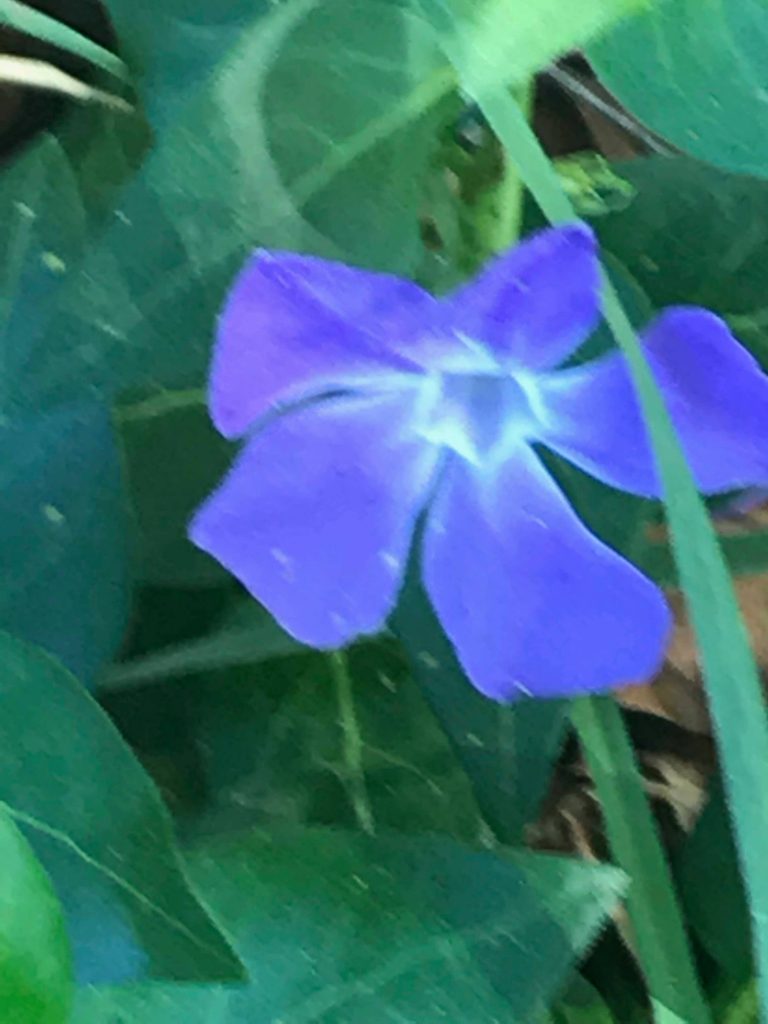
The next plant I saw on my journey was the periwinkle, species name Vinca Minor. It is also known as dwarf periwinkle, or in the United States, myrtle or creeping myrtle. It stays close to the ground, occasionally going up to 40 centimeters, but no higher than that. It is a highly medicinal plant, which contains more than 30 alkaloids.
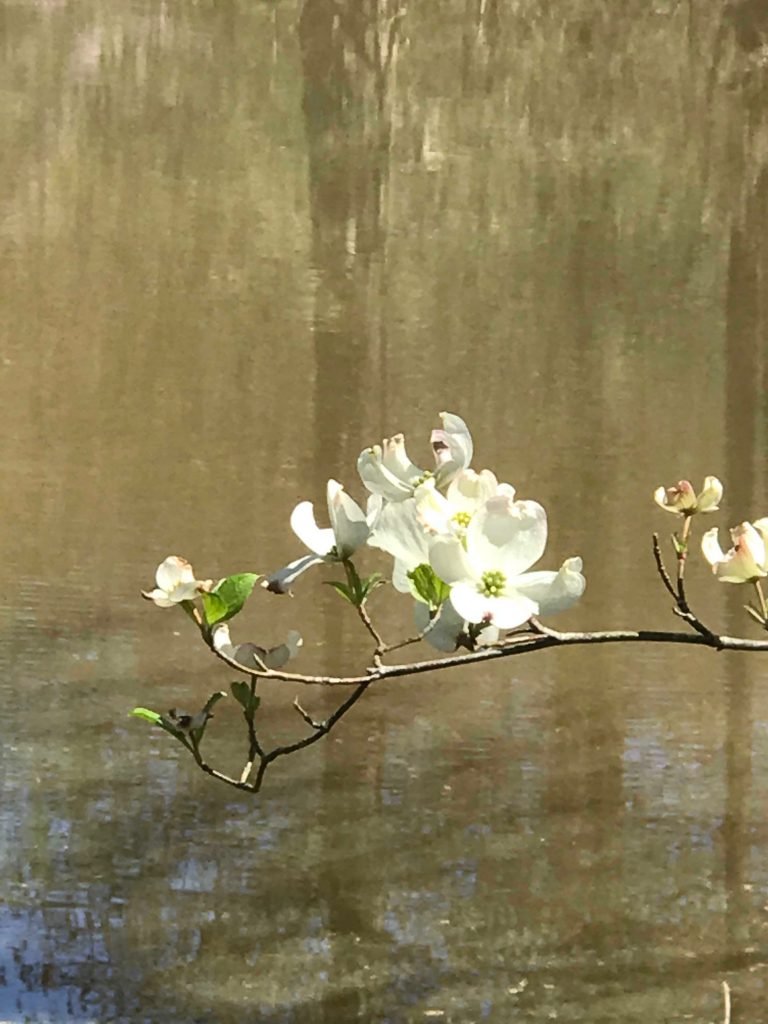
The flowering dogwood tree is located near the lake, a small deciduous tree that is native to both North America and Northern Mexico, and used in the production of inks, dyes, and quinine (used for medicine). In 1941, it was named the official state flower of North Carolina.
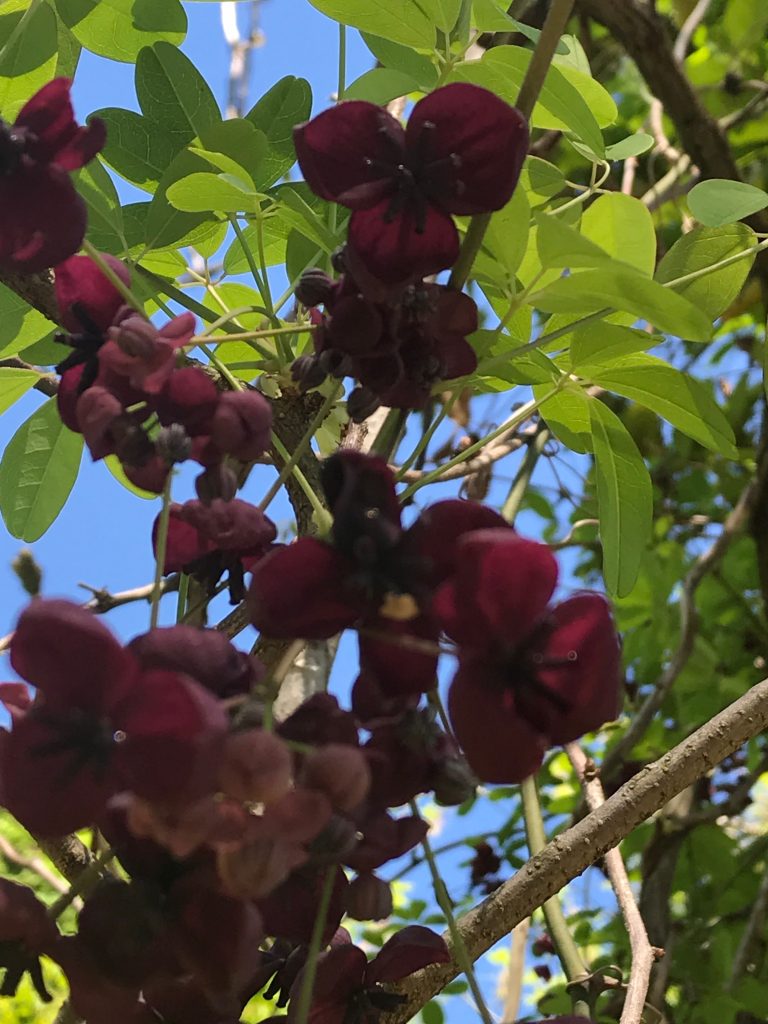
This was by far my favorite flower, even though it took me a while to identify it! The dark, yet tender blush of the petals is such a great contrast to the light green and the blue sky, making it a true spectrum of primary colors. This is not a single species; rather, it is a hybrid magnolia also known as the saucer magnolia, a deciduous tree with flowers that bloom early, centralized primarily in the East and West coast. This variety, Jurmag1, has the darkest and tightest flowers, which are a sight to behold.
Price Park & its Boundaries
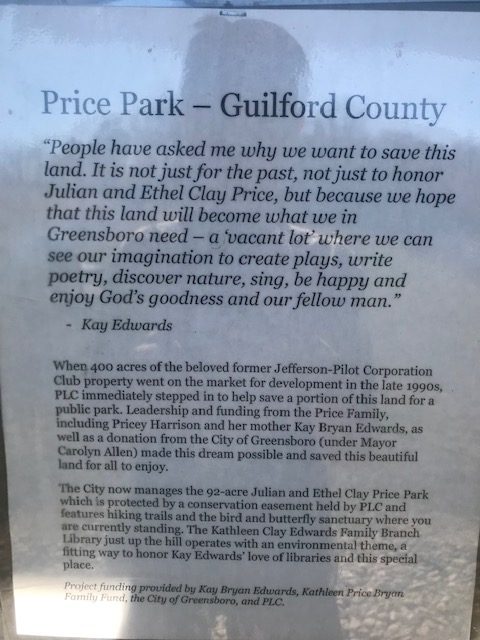
Price Park is a public park, which was founded officially in 1999 by a generous donation to the Piedmont Land Conservancy from philanthropist Kay Edwards. Almost immediately, stream reconstruction was beginning, and things like bird and butterfly meadows were put in to try and fix some of the damage that humans had done to the land over years of disregard.
While all of these efforts to “fix” some of the things that went wrong are certainly better than nothing, I wonder to what extent these restoration attempts are helpful — and, more importantly, for how long.
Price Park is a 98 acre spot where humans and animals are meant to co-exist peacefully, but what about what is around the park? There is no land conservancy stopping people from continuing to develop things like New Garden Shopping Center, the busy bordering roads, or Jefferson Woods, a neighborhood packed full of mansions (lying just behind Price Park, opposite New Garden Road). So, in other words, how long lived will Price Park be, with this seemingly never-ending flow of development? How long will the conservationist efforts and large sums of money have the ability to make a difference, and how long will people actually care? They are daunting questions to ask, but every time I go to Price Park — a public space — and walk to the back, where there is a small human-made lake, and see the towering mansions of Jefferson Woods staring me down, questions like these flood my mind.

I know that Price Park has no control over what goes up around it, but I wish it did. Or even just that people bordering the park would care enough to make active efforts not to deplete the 98 acres of natural habitat next to them. Hopefully I am not wishing something that is unachievable, but at the rate things are going now, I am afraid that I am.
Human Presence in The Guilford Woods
Whenever we go into a natural area that is well loved, any area for that matter, we tend to take each stride more affirmatively than the last, we glance around, not just with a sense of exploration, but with pride. Pride that we get to experience this place? Maybe. But the idea of dominion over land alters how we conceive land use, what we believe about our rights and responsibilities to the land, and even what we leave behind. On April 9th, I walked in the woods, by myself. Previous pictures that I’ve taken in the woods have always been when I was in the company of others. I’ve always been navigation-challenged; last year, when Guilford College’s literary magazine group, The Greenleaf Review, held a writing retreat, I went, had a fantastic time, and got lost in the woods the last day of our retreat after breakfast, because I wanted to go walking. Before we have conceptions of how we use the woods, we also have conceptions about WHO can use the woods. We had the opportunity to read a book by a renowned ornithologist, Drew Lanham, called The Home Place: Memoirs of a Colored Man’s Love Affair With Nature. As a Black ornithologist, he feels very much like an outsider in nature, given that fewer than 10 birders are Black, and the profile of a naturalist is one of White, middle aged males. While my struggle isn’t quite so tremulous, I wanted to give myself the confidence that I would be able to go into the forest and successfully come out without having to take anyone with me, or ask for help. So I set off.

Then there was a series of storm drains. I found quite a lot of these overlaid throughout the trail, and probably would have found more had I walked further. In total, I found 6 drains. Some appeared to have been touched sparingly since they were first installed, but one was heavily decorated with Guilford-inspired graffiti that surprisingly mirrored the colors that were used on the second graffiti installation I saw, though that was nearer to the lake.
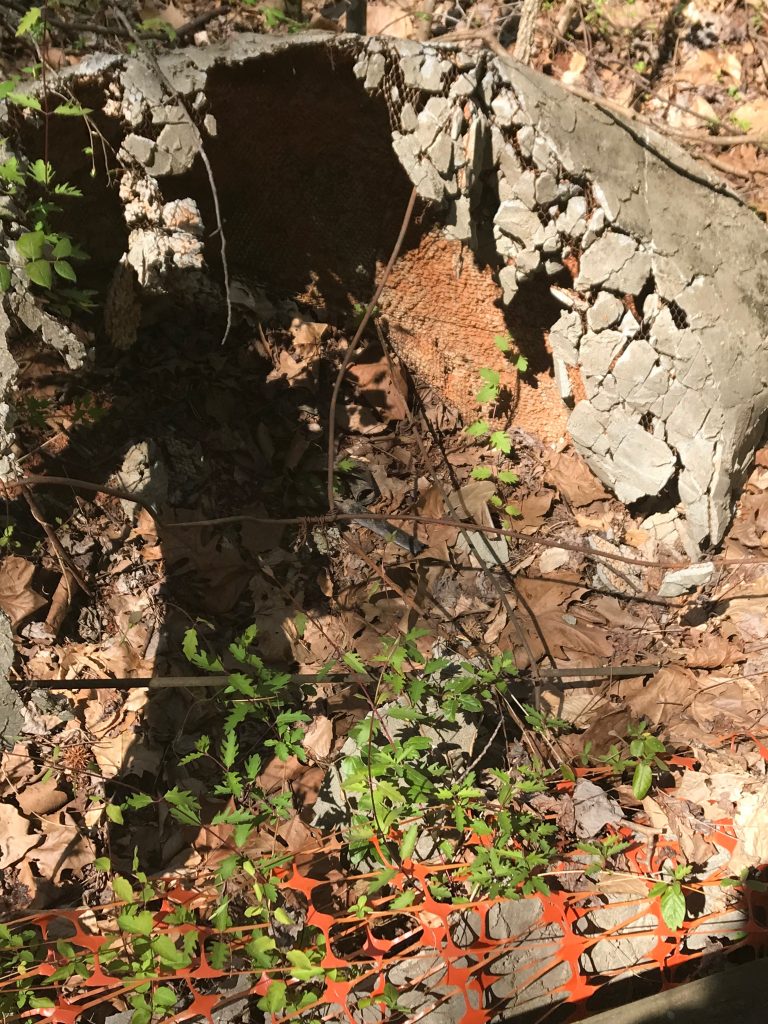
The third category of man-made objects were bridges. While it may seem pointless to categorize given that so much of the structure of the woods and the trails has been man-made, a lot of these structures differentiate the Guilford Woods from a natural overgrowth of “woods.” The left and center photos were found in the forest, and as you’d expect, they are far more decrepit than the bridge near the lake, outside the Woods, especially the bridge in the center which was missing a rung. I imagine it must serve as a cool, dark hiding place for various insects like termites, or animals like raccoons.
I believe man-made influences not only change our ideas of the forest, but also influence what we do in the future to it.
Dandelion Dreams
There’s something incredibly funny about two adults making wishes on dandelions. There’s also some undoubtable childlike sweetness in the act. This was my most recent trip to the Meadows. My friend and I went there on a walk to have an arduous discussion about some rather “adult” topics. Our conversations lasted all evening and into the night, mulling over all the things we probably should have mulled over a long time ago. Hours past and suns set. And after all those hours and as we got ready to head out of the Meadows, we had to pause one more time. The silly, seussical weeds that surrounded our feet were absolutely screaming our names.
In a cleansing moment of relief, wishfulness, hope, and pure love, we expelled all of our troubles on these poor unsuspecting dandelions. With each humid breath of April air, I felt my worries of the past and my insecurity about the future fade into the breeze alongside the fluffy dandelion seeds. As self assured as the children who confidently make wishes on the same flower, I sought to regain that sort of whimsy. I can’t exactly remember what it is I wished for on this night, but it’s reminded me to keep making wishes. To try to look at the world through a child’s eye sometimes. To take things seriously and participate mindfully in conversation with myself, with others, and with the space around me, but not to forget that there is still silliness in nature. I think we have to find these moments of childish joy and delight amongst all the density and drudge of human society.
Oddly enough, on a totally separate yet recent occasion with a different friend in a different part of the woods, I went on a quest for dandelions to make wishes on. We walked all over Guilford’s campus, which was not yet covered in dandelions as it is now, searching for the opportunity to make a simple wish. We need these things! See how hard we work to find them? We need to have little glorious moments of hope sprinkled in between the towering pines and across the scratchy grasses.
On Pinecones
Wandering in the Guilford woods, there are fewer pinecones than I expect. I find one, small and green, closed tightly around itself. I try to pry open the scales, but it feels glued shut, and a sticky resin now coats my fingertips. Rolling my hands together, the pine resin doesn’t budge.
There are only a few pinecones that have opened up for the season, ready to release seeds. Pinecones only open up in the heat, careful to protect their seeds. They don’t necessarily drop every season, or every year; some of them can cling to the tree for up to 10 years. They’re in no rush, and don’t need to follow our sense of time. For a tree that can live over 150 years, 10 years is a blink. They want to nurture their cones, let them grow and mature, and finally, when they’re ready, release them to the ground, where they only have a small chance of spreading the seeds.
Loblolly pines usually grow in muddy areas; the word “loblolly” actually means “muddy puddle.” The pinecones drop in areas ready for fertilization. The “female” cones are the ones that hold seeds, and the ones that we see and pay attention to. The “male” cones are simply pollinators, apparently rarely noticed.
Pinecones have been a source of symbolism, of art, throughout my life. In preschool we made turkey decorations out of them, sprinkled them with cinnamon and created feathers out of pipe cleaners. It’s something that still sits in my family’s house, hidden on a shelf, brought out around Thanksgiving. At summer camp, we used to throw them into the fire, watch them pop and explode. It’s a symbol of letting go, but also of memory and rebirth. A program here in Greensboro for kids dealing with a parent’s cancer has a tradition of throwing pinecones into fires after sharing their fears and their grief. It’s a way of letting go, but also of hope.
I once met someone who, whenever she was struggling with loss, would build a fire and toss a pinecone in it. “They only release their seeds in fire,” she says to me. “I don’t know, it feels like a metaphor.” She tosses a pinecone into our campfire. She doesn’t say what she’s mourning this time.
I can’t help but feel excited whenever I come across a pine cone that hasn’t been chewed up by a hungry squirrel or other animal. There’s something beautiful about a whole pine cone, freshly fallen and open, ready to tackle the world, yet still so fresh and new. They’ve been around long enough that we have fossils of ancient pinecones, yet they still remain nearly the same. They’ve figured out a system that works, and they’re consistent. The pinecones know what they’re doing. They may be new and fresh to this world, but their tall, tall parents watch over, guide the cones with their roots, and continue to grow.
The Biggest County in America
With my post today I would like to history about the surrounding area Botetourt County, Virginia. The reason I name this chapter the biggest county in the world was because Botetourt County was is a very vast open expensive land. It extended to the Mississippi River which covered Kentucky, parts of West Virginia, Indiana, Ohio and Illinois.
The land was mainly settled by the English and east and the Germans and the mountainous west of Virginia, it will be now know to be Franklin County and Roanoke County. Some important figures of the time where col. William Preston of Botetourt, col. William Fleming who as of 1781 was the head of the local government commission. Andrew Lewis a militia commander at the battle of point Pleasant.

A little known fact is that George Washington when he was a militia col.,He rode around inspecting frontier forts and stopped at Fort William in Botetourt, and then went to what is now Roanoke to spend the night at a widows home. There is quite a bit to be said before the schools that popped up around this time. In the community of Salem, Virginia in 1842 Roanoke College was founded all while in Hollins the women’s school had been there since 1837 started out as raw milk female seminary, later to become Hollins College then University.
Hollins College was a female seminary school that went by the name of Valley Union seminary. It is one of the oldest institutions for higher education for women in United States. Although it is still a female college men are allowed to come and work at the graduate programs there. Some of the things people that attended there where Author Annie Dillard, sportswriter Mary Garber, good night moon author Margaret Wise.

Originally the buildings of Hollins College were going to be a resort area of the sort but when venture failed, the property and buildings were acquired for the seminary. After the start of the school in 1825 they hired a math instructor named Charles Lewis Cocke, he came with his wife Susanna and bought 16 slaves. In the same year of 1846 he started the first school for enslave people in the Roanoke area. Many of the slaves worked at the school and is pay received an education. In 1851 Cocke abolish the men’s department of the institution. In 1855 the name was changed to Hollins Institute because of a large donation.
Prior to being known is Roanoke the town was called big Lake due to the fact that there were many salty marshes in the area that attracted animals. Farming was a big contribution to the city when it was first starting out as well as in the late 1800s, because it but Industry and trade to the Blue Ridge Mountains and opened it up as a Route. Later on the county became known for railroads and a tractor residence to help build those does having a population boom around the time that they arrived.
All facts for this post were taken from:
Hollins Wikipedia page
the visit Roanoke website
